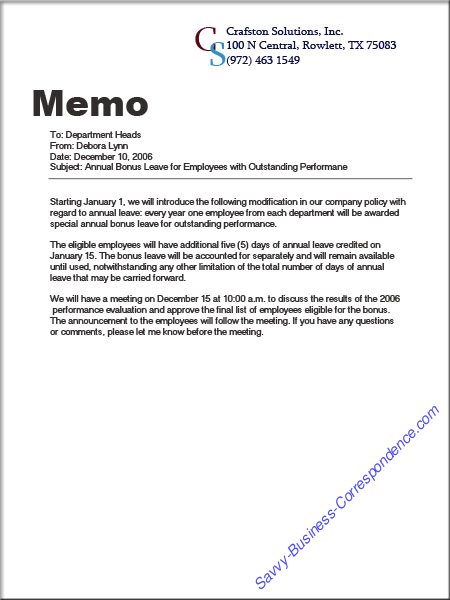Topic 4: A business letter and memo
Members: Helen Galkina, Jonathan Ouedraogo, Yiming Zhang
BUSINESS LETTER
A business letter is a letter which written in a formal language.
It's usually used:
- when writing from one business organization to another;
- or for correspondence between such organizations and their customers, clients and other external parties.
The overall style of letter will depend on the relationship between the parties concerned.
There are many reasons to write a business letter. It could be:
- to request direct information or action from another party,
- to order supplies from a supplier,
- to identify a mistake that was committed,
- to reply directly to a request,
- to apologize for a wrong,
- simply to convey goodwill.
Instructions:
- Start with basic company or formal letterhead. Make sure your address is included at the top, along with your contact details and company logo if applicable.
- Write the date. Place the recipient's address two lines below the date, above the salutation. Include name, formal title, company name and the office address.
- Type the salutation two lines below the recipient's address. Address the recipient using "Dear," followed by the individual's title and last name. Remember to add a colon rather than a comma after the last name. Use "To Whom it May Concern" or "Dear Sir/Madam" if you do not know the recipient's name or gender. (Note!: Mrs /misses/ - married; Ms /miz/ - married or unmarried; Miss /mis/ - unmarried)
- Begin your intro paragraph. Talk about why you are writing the business letter and what you would like to request from the recipient. State your position if presenting an argument. Reference events, meetings or individuals that are familiar or relevant to the reader.
- Elaborate on the purpose or main topic of your letter in the body. Provide examples supporting your argument, request or proposal. Give details on product features and benefits, as well as customer testimonials if selling to a client or prospect.
- Follow the body with your conclusion. Reiterate your initial request or position. Thank the reader for her time and consideration, and tell her how she can contact you for further questions or information.
- End with a complimentary close two lines down from the last sentence of the body. Allot four spaces for your signature and printed name.
MEMO
A memo is a note, document or other communication that helps the memory by recording events or observations on a topic, such as may be used in a business office.
A business memo is widely used by organizations to communicate to its member's pertinent information in an effective and efficient manner. The information communicated reflects policy changes, new products being introduced or new developments in solving new or current business problems.
The typical structure for a briefing note includes:
- Fill out the header information.State clearly who the memo is to, from, the date, and what the memo is regarding. Begin with why the recipient is receiving the memo (the subject).
- The first paragraph should be a purpose statement that can be as simple as, "The purpose of this memo is to..."
- Include a brief summary of the problem or need you are writing about. The body of the memo should expand on these themes.
- State any actions you need the recipient to perform and when you need them performed by.
Close with any follow up items required from the recipients. Also, make sure the ending is courteous and respectful to the readers. Even if you are communicating difficult news remember to do so in a poised and dignified manner.
A business memo also may be a call for action for all team members to become involved in. Writing a business memo is a great tool for leadership teams. Make it short, one page if possible. Bulleted lists are an easy way for the reader to understand the key points of the memo immediately.
The Difference between Business memos and Business letters
Business memos are usually internal, that is between employees within a business, company or organization. Memos use short sentences, less formal language, and bullet points to convey important information. Memos always contain a header that tells who it is from, who it is to, the date, and the subject.
On
the other hand, business letters are usually between two businesses or a
business and its clients. Because of this, business letters tend to be longer
and use more formal language
About the
format:
Heading
Heading
- Business letter include an address block and an inside address. Omit your name from the address block, spell out street and state names, and end with the date. Skip two spaces and begin the inside address. Start with the recipient's name, title, and address. For memos, headings include the following: to, from, date, and subject, with a colon and one blank space after each. Senders should initial their names.
- In business letter, place the greetings two lines below the heading. Greet a person and add a colon. Unlike a letter, salutations are not used in memos, which begin by directly stating the purpose of the document instead.
Body Paragraphs
- When writing a business letter, body paragraphs begin two spaces below the heading. Use single spacing within the paragraph and add two blank spaces between paragraphs. Memos often contain headings and lists, which may use numbers or bullets to summarize main points.
Closing and Signature Block
- Close with the words sincerely yours. Leave four blank lines, and then include your name and honorifics. Memos do not contain a closing or signature.
work cited:
1. http://en.wikipedia.org/wiki/Business_letter. 9/11/2012
2. http://www.ehow.com/how_8662903_write-business-letter-sample-consultant.html. 9/11/2012


No comments:
Post a Comment